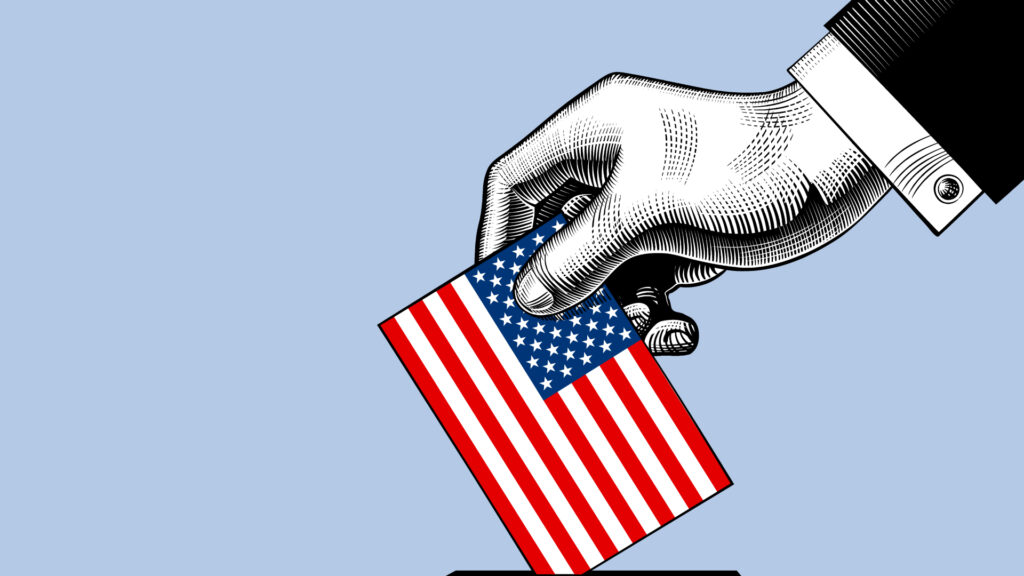Do what you feel in your heart to be right – for you’ll be criticized anyway
– Eleanor Roosevelt (1884-1962) American political figure, diplomat and activist, First Lady of the United States from 1933 to 1945.
The third of November 2020 is fast approaching. In Europe we are aware of the adrenaline surrounding the US elections, but it’s quite a challenge to understand how they work. Firstly, the American voting system is structured to protect smaller federal states from the danger of never being represented in Congress (Congress is to Americans what Parliament is for states like Italy, France and Spain). Their system is designed to ensure that the votes of the less populated states carry some weight, and is calibrated on a society that used to be based on agriculture. That is why the election is always on the first Tuesday of November: Sunday was Mass, and Wednesday was market day, while Tuesday was a day that gave everyone the opportunity to participate. It was established in November because it’s after the harvest and before the winter months, during which, at the time the system was established, it was difficult to travel by carriage.
American citizens do not vote directly for the President, but for an Electoral College, which in turn elects the President. There are 538 members in the Electoral College, allocated by state according to population (thus California, one of the most populous states, has 55 representatives in College, while Alaska has only 3, and so on). The voters put a cross next to the name of the presidential candidate on the ballot paper (so this year it will be Donald Trump for the Republican party and Joe Biden for the Democratic party), but in reality they are voting to send a team of electors to the College. The College electors represent the people, and it’s a “winner-takes-it-all” system (this is true in all states except Maine and Nebraska, which have a proportional system): the majority of votes in every single state decide what colour all the representatives of that state will vote for. Let’s explain with an example: if in California, from the 10 million citizens entitled to vote, 7 million vote Democrats and 3 million vote Republicans, all of the 55 California electors in the College should vote for the Democratic candidate in College, with no representation given to the 3 million minority votes. They should, but they do not always, vote for what the people ask for. The voters in the College who make-up their own minds are called “faithless electors“. In Italy this would not go down well, but in America it is legal (for now).
To become President a candidate must have 270 electoral College votes. Since the number of voters in the College is even, a tie can occur (it happened only twice in the history of the United States, in 1800 and 1824). In this case, the House of Representatives (the equivalent of theHouse of Commons in the UK) elects the President, while the Senate (similar to the Lords) elects the Vice-President.
The Electoral College is the reason why in five cases, the most recent of whom were Gore vs. Bush in 2000 and Clinton vs. Trump in 2016, the candidate who won is not the one who got the most votes. In 2016, once the votes were counted, Clinton had about 48% of the votes against 46% of Trump, but she still lost because she received 227 votes against Trump’s 304 in College.
This imbalance is also the reason why the campaigns focus primarily on swing states, or battleground states. Al Gore lost because of Florida, perhaps the most important of the swing states, with 29 electors in College. Clinton lost because of Michigan (16 voters), Wisconsin (10) and especially Pennsylvania (20). These three states would have been enough to reach 273 votes and win the presidential race. So if you are wondering why the newspapers are obsessively talking about Pennsylvania these days (a state that has just over one fifth of the population of Italy), this is the reason.
This also explains why the election campaign is so long and adrenaline-charged: the few guaranteed states (California, New York and Illinois for the Democrats, Texas and the southern states for the Republicans) do not automatically bring victory for either side. From here it is easy to understand the reason for the intense campaigns to invite people to vote: in a system that is “all-or-nothing”, every vote – literally – counts. The election is decided by the undecided or the absentee, rather than the one who always votes Democrat or Republican. Those who do not usually vote, or who change their opinion, are the cornerstones on which the political campaigns of one party or another are fought, especially if statistical analysis confirms that the profile of the absentee corresponds to a useful vote.
What happens on Tuesday will affect us all. All we can do is watch and hope that America makes the correct choice.
Over the Pop
Obama Out and The Donald | This is Obama’s closing speech at the White House Correspondents Dinner in 2016. Relaxed and almost out of his official role, he entertains an overexcited audience of journalists with eighteen minutes of elegant insults. The mic drop at the end is pure gold.
Deer Hunting with Jesus by Joe Bageant | The book is an angry, compassionate and yet genuinely funny recount of that part of America which is largely invisible from Europe. Rural America, far from cities and Hollywood, embodies ideals that are difficult to understand for Europeans: free weapons, religious sects, private health, death penalty, excessive capitalism. To be coupled with Borat (see below) if you want a tour de force in what the newspapers rarely explain.
Borat 2 – Borat Subsequent Movie film | For VERY strong stomachs. Suggested here partially because I am still digesting it, partially because it is topical, if you have the stomach for the vitriolic satire of Sacha Baron Cohen do not miss Borat 2, just released on Amazon Prime. The movie, like all Baron Cohen’s works, goes way, way beyond laughing (even the uncomfortable ones, even the ones where you are cringing through gritted teeth). It made me think about the reality it represents – well known to anyone who follows the American cultural background – but it also made me think about the statistical representation of the characters told in this story: I wondered if this is really the predominant side of America (Joe Bageant thinks it is) or if, like every director, he had to seek out the most extreme among the extremists, to give some depth and movement to the movie. I don’t know the answer of course.
 This article appeared for the first time on our fortnightly newsletter. To keep up with the scientific debate, join the community of Monnalisa Bytes and to receive a preview of all our newsletters subscribe here!
This article appeared for the first time on our fortnightly newsletter. To keep up with the scientific debate, join the community of Monnalisa Bytes and to receive a preview of all our newsletters subscribe here!
